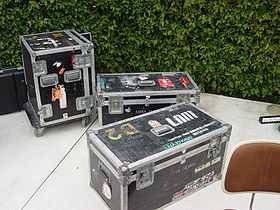Road case

A road case, commonly referred to as a roadie case, is a shipping container specifically built to protect musical instruments, motion picture equipment, audio and lighting production equipment, properties, or other sensitive equipment when it must be moved between locations, or frequently thrown around by airport baggage-handling personnel. A large number of varying-sized road cases can be built to outfit the needs of an entire touring production company, or custom designed individually for a specific industry or product.[1]
The term is mostly used in the United States and implies that the case is primarily for road based travel, unlike a flight case. The term originates from its use for storing and shipping band equipment while the musicians were on the road. The singular term can be used interchangeably with ATA case and flight case.
History
The history of road case design is based on an airplane parts packaging specification. It was designed by airline packaging engineers. The specification is ATA 300 Category 1. IATA is The International Airline Transport Association located in Washington, D.C. and consists of members of Boeing Airlines, Airbus, Fed-Ex, American Airlines, United Airlines, Northwest Airlines and Delta Air Lines. ATA 300 Cat 1 cases are designed to withstand 100 trips and Cat 2 containers are rated for 10 trips. The original design required the cases to be white, so they would not be left on the airport runway when loading cases at night time. The first ATA 300 spec was published on August 1, 1960.[2]
Construction
Most road cases are constructed of three main layers. An outer layer of ABS laminate is adhered to a middle layer of lightweight 3/16" to 1/2" cabinet-grade plywood such as birch, poplar, or maple. These two layers are known as laminate panel, and high grade cases are made from composite material such as Plasti-Clad. Inside the case, an internal shock-absorbing layer such as polyurethane or polyethylene foam is adhered to the walls of the middle layer with negative space removed that corresponds to the exact shape of the component which it is preserving. The edges and corners of road cases are further reinforced with aluminium angle bar or extrusions, and form-fitting metal case corners which are cast and often coated in zinc or nickel. Caster wheels are often built into or attached to the case for ease of transit. Transit cases differ from road cases in that they are typically made of molded plastic in the case where waterproofing is a concern; manufacturers such as Pelican and Storm sell plastic road cases that can be outfitted with a custom foam interior. All road cases, wood or plastic, may be further customized to suit any application; for example by adding a power adapter and a computer fan, certain equipment may operate while on the road without leaving the protection of the road case. While road cases are available in an incredible variety, the North American standard size is roughly 30"W x 44"L x 33"H including the casters.
Uses
Typical uses for road cases on tour are wardrobe, hair and make-up, catering, rigging, backline, sound, lights, video, production and carpentry. Road cases got their name because they are usually used by touring entertainment companies that need to take their show out 'on the road'. Road cases configured with rackmounts are widely used on the road for pro audio, lighting, sound recording and video. Other applications include motion picture production, military, sports, medical, rental and staging. Road cases are also called ATA Cases, Reusable Shipping Containers, Custom Cases, and Flight Cases.
See also
- Transit case
- Flight case
- Trifibre